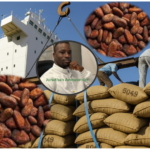
Exporting Pollution: The Global Footprint of Ghana’s Galamsey (illegal mining)
Galamsey is often framed as a domestic crisis, brown rivers, scarred forests, poisoned soils. But in a globalized economy, what is extracted, processed, and traded in Ghana rarely stays in Ghana. Mercury-tainted gold, heavy metal-bearing cocoa, pesticide- and cyanide-laden produce: these can all travel quietly into foreign markets and dinner tables. When that happens, our national problem becomes an international one, with consequences for public health, trade reputation, and livelihoods. The simple but uncomfortable question is, are we exporting more than commodities? Are we exporting contamination?
Local Mercury Has Become a Global Problem
Artisanal and small-scale gold mining (ASGM) commonly uses mercury amalgamation: miners mix mercury with ore to bind fine gold, then burn the amalgam to recover metal. The mercury that isn’t vaporized (and inhaled) often washes into streams, enters sediments, and bioaccumulates through fish and crops. The Minamata Convention exists precisely because such practices harmed communities worldwide for decades; phasing mercury out of ASGM is now a global public-health priority.
In Ghana, the consequences are no longer abstract. In Atiwa East (Eastern Region), recent field reports by the Institute for Environmental and Sanitation Studies (IESS) highlighted cassava harvested near galamsey zones with mercury levels far above accepted safety limits, underscoring how metals can move from pits to plates via groundwater and dust deposition.
When mercury follows our supply chains, it stops being just “Ghana’s problem.” Gold refined from mercury-contaminated feedstock can enter international bullion markets; while refiners and responsible-sourcing programs screen for risks, gaps remain, especially with informal supply. That is exactly why international initiatives are pushing mercury-free technologies and tighter due diligence for ASGM supply chains.
Bottom line: every gram of mercury and cyanide we fail to control at home can echo in export markets, compliance audits, and consumer trust abroad.
Cocoa, cadmium, and the reputational risk of “contaminant footprints”
Cocoa is the livelihood of hundreds of thousands of Ghanaian households and the backbone of our export earnings. But soil metals and mining-related disturbance can influence the cadmium (Cd) content of cocoa beans. The EU regulates Cd in finished chocolate, with strict limits that buyers push upstream to beans; several guidance notes warn producers that even 0.3 mg/kg in beans can jeopardize powder lines.
Most West African cocoa performs acceptably against these limits, but the direction of travel is clear: tighter controls, more testing, and purchase contracts that penalize exceedances. Now galamsey has expanded into cocoa landscapes, shifting soil chemistry shifts (acidity changes, metal mobilization), this could nudge cadmium upward, risking rejections, discounts, or reputational harm.
And regulations aren’t stopping at contaminants. EU deforestation-free rules are already reshaping cocoa trade by demanding full traceability from farm to port, a risk-management model that will likely extend to more food-safety and contaminant metrics over time. Ghana is piloting polygon mapping and end-to-end tracking; failing to meet the new bar could shut us out of key markets or shrink margins for farmers.
When Food Exports Carry Hidden Toxins
Mercury and cadmium are not the only worries. Illegal mining can mobilize arsenic, lead, and cyanide or elevate pesticide use as agriculture shifts around disturbed landscapes. Route-to-market pathways include:
- Soil-to-root uptake (cassava, leafy vegetables) where soluble metals infiltrate edible tissues.
- Irrigation and processing water contaminated by upstream mining effluent.
- Dust depositions on cocoa pods and food crops near haul roads and wash plants.
- Fish and aquatic foods from rivers with metal-rich sediments.
The public-health consequence is chronic, low-dose exposure, not dramatic poisonings, but incremental risks to kidneys, liver, neurological development, and cardiovascular health over years.
4) Trade, trust, and the price of contamination
Export markets run on trust and trust runs on standards. Consignments flagged for contaminants don’t just face short-term delays; they trigger heightened scrutiny across entire product lines and origins. That can translate into:
- Higher compliance costs (testing, certification, segregation) pushed down to farmers and processors.
- Discounts or outright rejections when risk-averse buyers pivot to lower-risk sources.
- Brand damage to “Ghana origin” in cocoa, fruits, or fish, which takes years to rebuild.
Ghana has begun to adapt traceability in cocoa, voluntary mercury-free pilots in ASGM, stepped-up testing by regulators and private labs but the gap between the scale of galamsey and the pace of governance remains the core problem.
Policy Choices in Front of Us
- Stop mercury at the source. Swiftly operationalize a mercury-phase-down for ASGM with affordable, proven mercury-free circuits (gravity concentration, borax smelting) and real incentives for miners to formalize; align enforcement with technical support so compliance is feasible, not just punitive.
- Protect food and water buffers. Enforce no-mining buffer zones around rivers and irrigation intakes; prioritise hot-spot surveillance (like forest reserves) with public reporting of contaminant levels in staple crops and fish.
- Trace, test, and tell. Expand export-grade residue testing and publish results to build buyer confidence. Couple this with farm-to-port traceability, what the EU now expects on deforestation will likely become the template for contaminants too.
- Align liability with profit. Where contamination is documented, pursue cost-recovery from those who caused it, so taxpayers and smallholders aren’t left underwriting reclamation, medical costs, and trade friction.
A Closing Question for Ghana and for Our Buyers
If we want the world to keep buying “Ghana,” then Ghana must be auditable: clean rivers, clean beans, clean bullion. The alternative is a slow erosion of market access, one residue test and rejected lot at a time. Our exports should carry our craft and credibility, not our contaminants. Ghana must wake up, before our global reputation is another resource we’ve mined away.
The writer is a GH Research Scientist based in Miami, FLorida-USA and a Contributor to National Discourse.